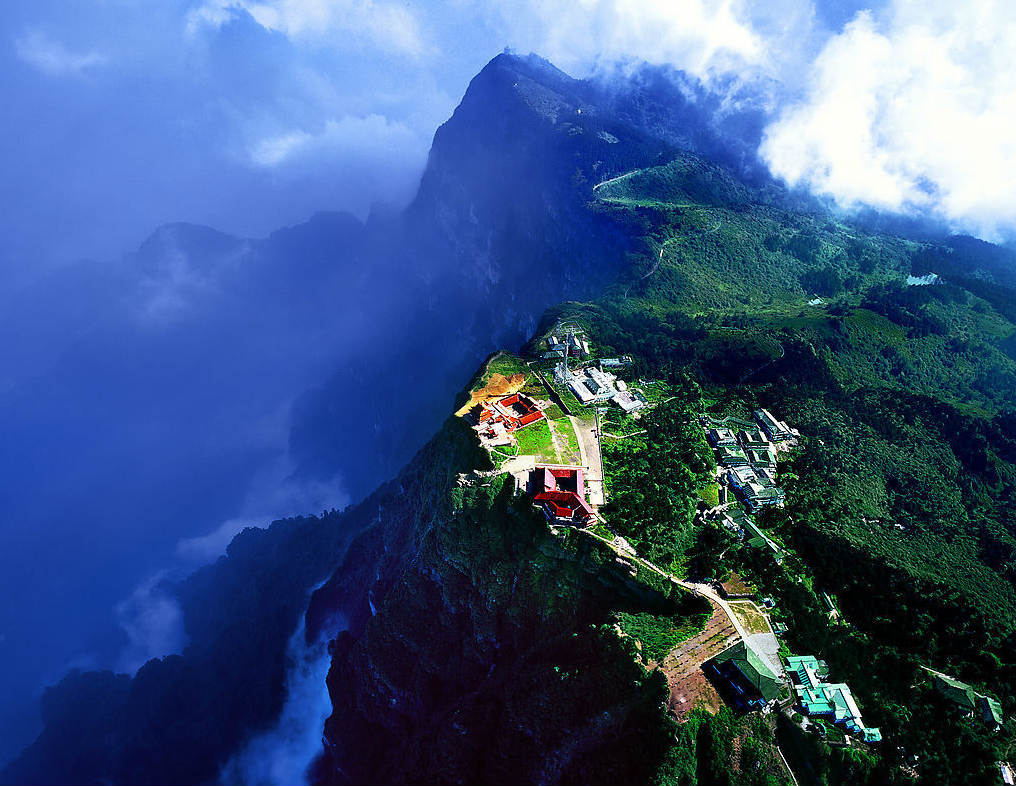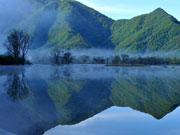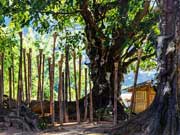


A bird's eyeview of Mount Emei.
It’s a trip to southwestern China’s Sichuan province, and more specifically to a famous scenic spot: Mount Emei.
From the base of the mountain, the vehicle climbed a steep and winding trail through dense trees. I looked out the window and saw soft light filtering through the clustered tops of the tall trees that seemed to touch the sky. As we made our way higher up the mountain, the air outside got cooler and fresher, and the rich greenery changed from temperate broadleaf forests to subalpine pine forests.
We arrived at the visitors’ center and took a sky tram nearly to the peak of the mountain at 3,099 meters (10,167 feet). From there, I saw a more complete picture of the location. Standing on top of a sea of clouds, the view of the forest was just magnificent. Eighty-seven percent of the mountain is covered by trees; that’s the official figure and also the impression I got from my own observations.
At the terminal we met several tourists hiking down the mountain. It was around 9 a.m. Their hardy outfits, slightly bleary, tired eyes and professional camera lens hinted at the purpose of their climb. While preparing for the trip, I learned that the mountain peak is a prime spot for photographers to enjoy a sunrise shoot. As we waited for the cable car, one man showed me his pictures: the ground and sky the same dark purple, the rosy clouds, a bright purple arch and finally an orange semicircle – the rising sun. The mist and clouds shaded the man’s palette of colors.
The scenic value alone justifies Mount Emei’s status as a UNESCO World Heritage site under natural criteria. However, in addition to its natural sights, the attraction also houses a number of important Buddhist temples, making it a mixed (both natural and cultural) heritage site. China has only four such sites.
A few minutes’ walk from the terminal is a large platform where rows of large incense burners are set out. Worshipers light and burn sticks of incense in bundles, which they wave above their heads while bowing. Some are simply casual tourists, while others are full-fledged monks dressed in maroon ropes. But all exhibit the same solemnity.

Silver frost highlight the marvelous snow-capped mountains, and gilded Buddhist architectures in southwest China.[Photo provided to People.cn]
The incense gave me my first real taste of the mountain’s Buddhist characteristics, though only because I missed the 55 temples scattered across the slopes on my way up. Baoguo Temple, Fuhu Temple, Wannian Temple, Huazang Temple, Xianfeng Temple – all are over 1,000 years old, and they helped to attract 3 million visitors to the mountain in 2015 alone, according to my tour guide. The mountain gained its first Buddhist temple some 1,800 years ago when the religion arrived from India; Mount Emei evolved into the center of Buddhism in China around the 6th century AD. It is the true cradle of Buddhism in China, and is one of China’s Four Sacred Buddhist Mountains.
I couldn’t have missed the mountain’s weightiest Buddhist presence, the 48-meter-high statue of Samantabhadra Bodhisattva, or Pu Xian Bodhisattva. The soaring object was right above my head, facing me. From a short distance, the colossal gilded statue is absolutely spectacular. Walking up to its base, there is a shrine within the statue where tourists can work toward attaining enlightenment.
Wearing a gold Buddhist crown and holding a Ruyi Rod in its hand, the Bodhisattva sits on a lotus platform placed on an elephant’s back. The elephant has a long nose and strong legs, with eyes looking ahead as if it is about to bring the Bodhisattva down the mountain to preach. Many visitors took pictures, some commemorating the fulfillment of a long-cherished wish to visit the sacred site. Others were simply marking the end of the arduous hike to the summit.
Next to the statue is another, much lower shrine, but with a brighter golden color so radiant that it dazzled even in the dreary overcast weather. It is the Golden Summit, the highest shrine of Huazang Temple, honoring the Manjusri Buddha. Huazang Temple is said to have been built during the Donghan Dynasty (25-220 AD), but it has since been rebuilt multiple times because of fires. The latest renovation began in 1986, when the government shelled out 3.5 million RMB to reinforce and update it. That renovation gave the shrine its eye-catching, shiny exterior. The work lasted until 2005. When the temple reopened to public in the same year, 108 eminent monks from China and abroad rallied to witness the grand event.
The Mount Emei scenic zone is actively cultivating tourism. From Oct. 11 to 13, the site is inviting visitors to view its bamboo forests. From Oct. 15 to 17, it will hold friendly mountain-climbing competitions for foreigners and locals. About 40 kilometers away is the 1,300-year-old Leshan Giant Buddha, the largest stone Buddha in the world. Approximately 130 kilometers away is Chengdu Panda Base, where visitors can witness the endangered species at play. And to fuel all that sightseeing, tourists can indulge in the local Sichuan cuisine, which always lives up to its spicy reputation. The area never lacks wonders.

The 1,300-year-old Leshan Giant Buddha, the largest stone Buddha in the world.

 Who Will Fit The Chinese Roles In Game Of Thrones?
Who Will Fit The Chinese Roles In Game Of Thrones? China's Hubei Shennongjia added to World Heritage List
China's Hubei Shennongjia added to World Heritage List Cute Dog At Fruit Stand Becomes Latest Internet Sensation
Cute Dog At Fruit Stand Becomes Latest Internet Sensation Top 10 livable Chinese cities
Top 10 livable Chinese cities The last primitive tribe in China
The last primitive tribe in China China's first intelligent security robot debuts in Chongqing
China's first intelligent security robot debuts in Chongqing A Total of 3,552 Subscribers Vanish In Two Days; YouTube Closes All Doors to Users’ Inquiries
A Total of 3,552 Subscribers Vanish In Two Days; YouTube Closes All Doors to Users’ Inquiries Out of this world! Futuristic UFO-shaped yacht has its own garden and a stunning underwater viewing deck
Out of this world! Futuristic UFO-shaped yacht has its own garden and a stunning underwater viewing deck An old tea house in Chengdu
An old tea house in Chengdu Furious Customer Crushes All the Buns from Vendor Just Because He Was Given the Wrong Flavor
Furious Customer Crushes All the Buns from Vendor Just Because He Was Given the Wrong Flavor